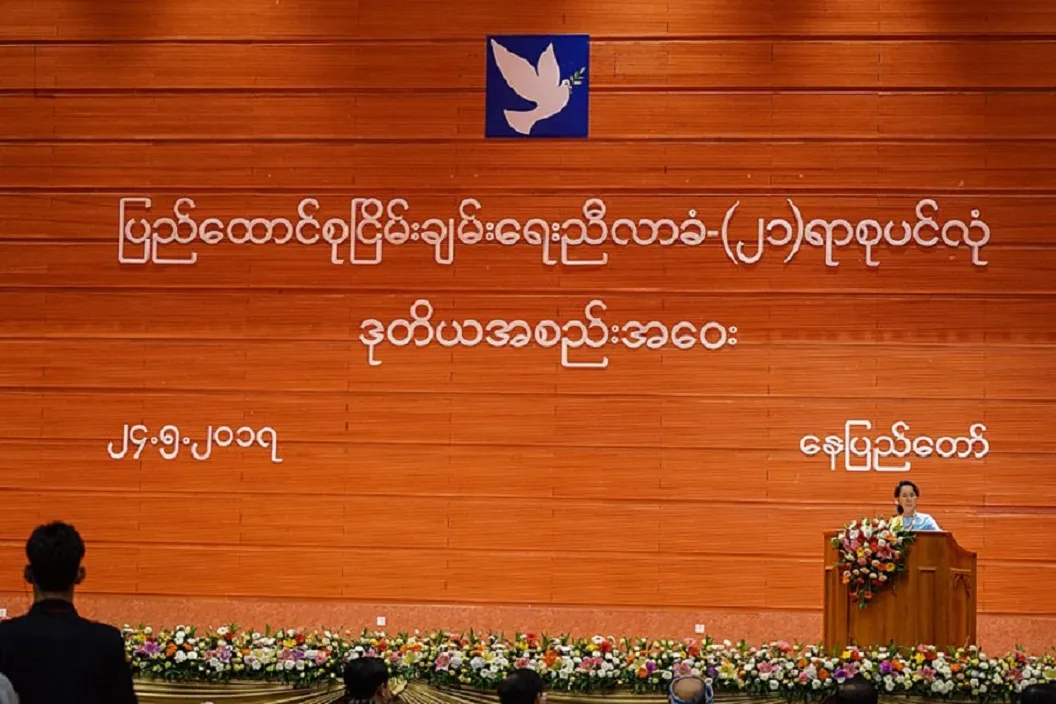Substate constitutions and peace negotiations

International IDEA is supporting constitution building processes as an integral part of the democratic transition in Myanmar. By working with various state institutions, ethnic based organizations, political parties, civil society organizations and academia, International IDEA supports a more inclusive and well-informed debate on constitutional issues also to create a common understanding of federal and constitutional principles.
Myanmar’s government, ethnic armed groups and political stakeholders are attempting to halt a 70 year civil war between Myanmar’s army and ethnic armed groups, partly by moving toward consolidating democracy and establishing a federal state. One of the options to achieving the latter is to amend the 2008 constitution based on the outcomes of the Union Peace Agreement, as mandated in the 2015 National Ceasefire Agreement (NCA). So far the NCA been signed by 10 ethnic armed organizations (EAOs), and another dozen are still negotiating with the government whether they will sign the NCA, seek a separate ceasefire agreement, or continue the armed struggle.
The NCA aims to be a stepping stone for the peace process, with the goal to secure both a peace agreement and a new political settlement among Myanmar’s stakeholders, which would transform Myanmar into a federal republic. It provides a formal channel for political dialogue, where not only the EAOs and the government are able to discuss federal and democratic principles, but where public participation will also be allowed to some extent.
The NCA included a roadmap to achieve national reconciliation and peace for the country. To implement the latter, the government of Myanmar has organized a nationwide peace conference—the XXI Century Panglong Peace Conference—which has taken place three times since October. Key to these negotiations has been the demand of EAOs for ethnic states to be granted self-determination, including the right to draft their own state constitution. While this was in principle agreed to by both the government and the military, EAOs were in return required to agree to a clause explicitly eschewing the right to secession, which they failed to do.
According to Dr Lian Hmung Sakhong, member of the Union Peace Dialogue Joint Committee and vice chairman of the Chin National Front, the EAOs’ demand to be able to draft and adopt their own substate/state constitutions is based on historical factors since gaining independence from Britain. State constitutions are generally defined as legal documents that “limit and structure political power at the sub-state level” to enable stakeholders at the substate level to organize and implement powers allocated to the substate entities. In the eyes of ethnic groups they provide the states with a high degree of self-governance and allow them to respect the rights of minorities in each of the states. Historically and politically, this demand stems from the 1947 Panglong agreement, signed by General Aung San and ethnic representatives from the Frontier Areas. This agreement guaranteed full autonomy to the ethnic states regarding their internal administration and included the fundamental principles to be accommodated in the future (1947) constitution of the Union. However, the 1947 constitution, which was enacted after independence, and which gave the rights to the states to draft their own constitutions (articles 165, 179, 194, and State Legislative List II), was never fully implemented, including the guarantees for self-determination that can be found in the Panglong Agreement, which is one the reasons for the beginning of the civil conflict.
At the same time, substate constitution making is not a new subject for many ethnic minorities in Myanmar. Alongside the military government’s 1990 constitutional drafting conference — ‘National Convention’ —exiled ethnic armed groups and other democratic forces drafted a parallel constitution which was however abandoned for ;ack of agreement between the groups on how the constition would protect the interest of the ethnic peoples in Myanmar. In 2000, the leaders of some ethnic resistance groups—Chin, Kachin, Karenni, Karen, Mon, Rakhine, and Shan—started drafting their own state constitutions, establishing their own drafting committees. While these substate constitutions were never formally adopted, they all reached different stages of development. The Chin State Constitution Drafting Committee, for instance, has drafted and amended its state constitution four times and has been working on its fifth draft since 2000. And it’s not only ethnic states that are interested in drafting sub-state constitutions - some regions within Myanmar have shown a similar interest. Since 2015, for instance, stakeholders in the Thanintharyi region of Myanmar far south have been negotiating a Tanintharyi Nationalities State Constitution, starting the drafting process, which has included different interest groups, civil society organizations, and was later joined by political parties and legal professionals.
International IDEA recently published a report on Substate Constitutions in Fragile and Conflict-affected Settings, which provides an analysis on how substate constitutions have been developed and designed in conflict-affected states after 1991 (or after the end of the Cold War). This paper was developed by Kimana Zulueta-Fulsher and Asanga Welikala, following the Third Edinburgh Dialogue on Post-Conflict constitution Building held in Edinburgh, United Kingdom, in December 2016. The report looks at both federal and unitary states that have adopted substate constitutions after the end of Cold War. The two key messages of the report are firstly, the right to draft and adopt sub-state constitutions does not necessarily mean that the substate entity has a high degree of autonomy, and secondly “constitutional space” is what determines the level of autonomy of a substate entity in structuring political power and designing its own substate constitution. Constitutional space is often the result of political negotiations among parties to the conflict, and it is always provided for in the central-state (or national) constitution. Furthermore, the paper also discusses the process of substate constitution building as well as design options for substate constitution makers. Interestingly, the design of substate constitutions mostly coincides with the central-state constitutional design. This paper was translated into Myanmar language with the aim of allowing the people in Myanmar to access this knowledge resource and be able to learn from comparative experiences.
With growing interest in the subject throughout Myanmar, International IDEA’s MyConstitution Programme organized a public launch of the Substate Constitutions in Fragile and Conflict-affected Settings policy paper in Myanmar version in June; participants from civil society organizations, government institutions, political parties, academia, legal professionals, and international organization attended the event. The purpose of this event was to support a better understanding of the content and issues around adopting substate constitutions. In addition, International IDEA intended to provide comparative case studies where the audience could learn from different approaches and challenges in the constitution-building process. Thus, International IDEA conducted separate one-day workshops with the Civil Society Forum for Peace, the Constitutional Tribunal, and the Attorney General’s Office to discuss the role of substate constitutions in federal states and the relationship between constitutions at both sub and central-state level.
Most participants in these workshops stated that Substate Constitutions constituted a new subject they did not know much about before. They also stressed that the workshop provided useful knowledge for their day-to-day work and research on constitutional issues. One of the participants, Tin Ko Ko Oo, a leading member of Tahnintayi Nationalities State Constitution Drafting Committee, said that “they even discussed and amended the draft state constitution based on the knowledge learned in the workshop”.
Based on the comments from the participants to the workshops and partners, International IDEA already plans to support further activities and workshops on sub-state constitutions to reach out to other stakeholders from both national and states/regions.





